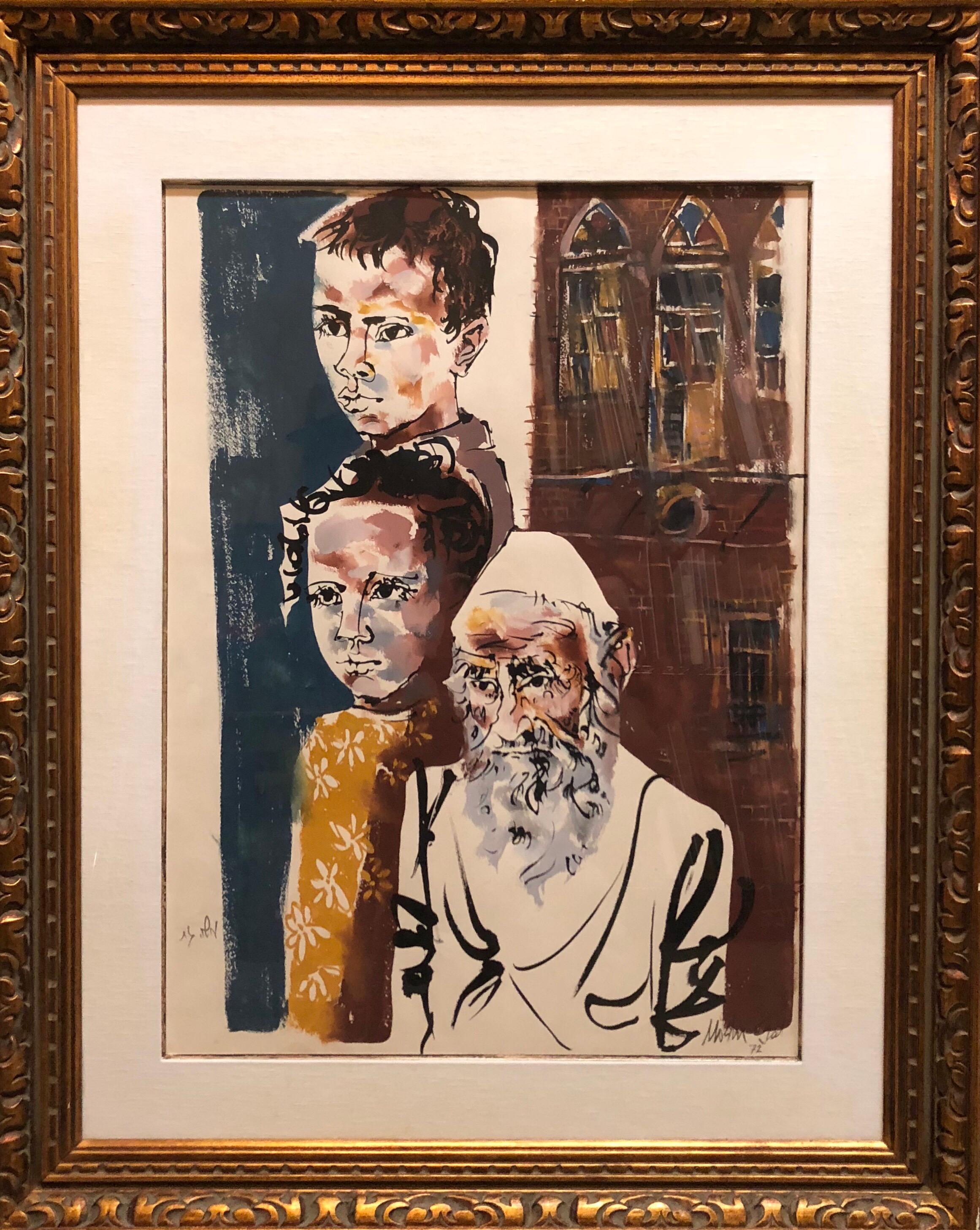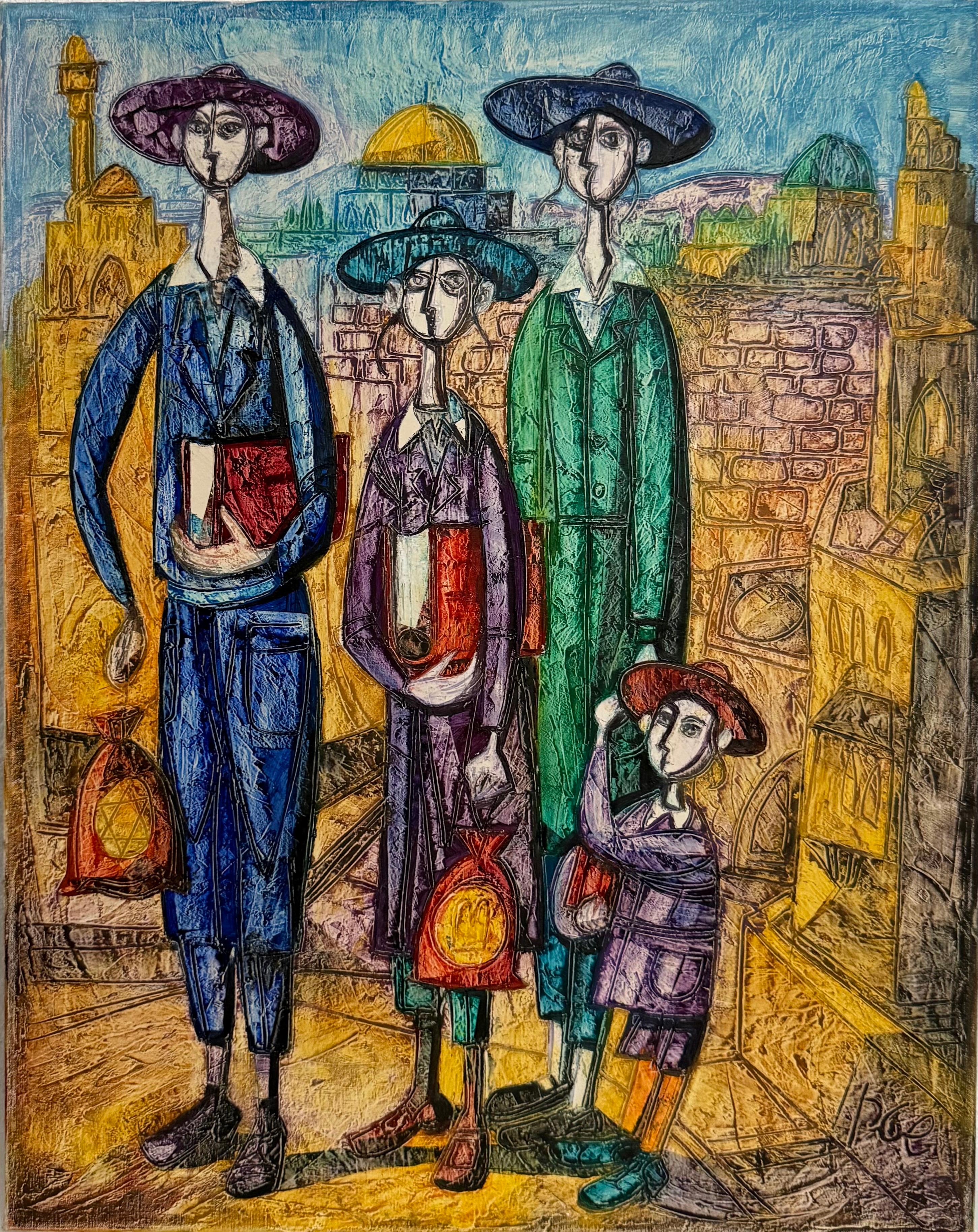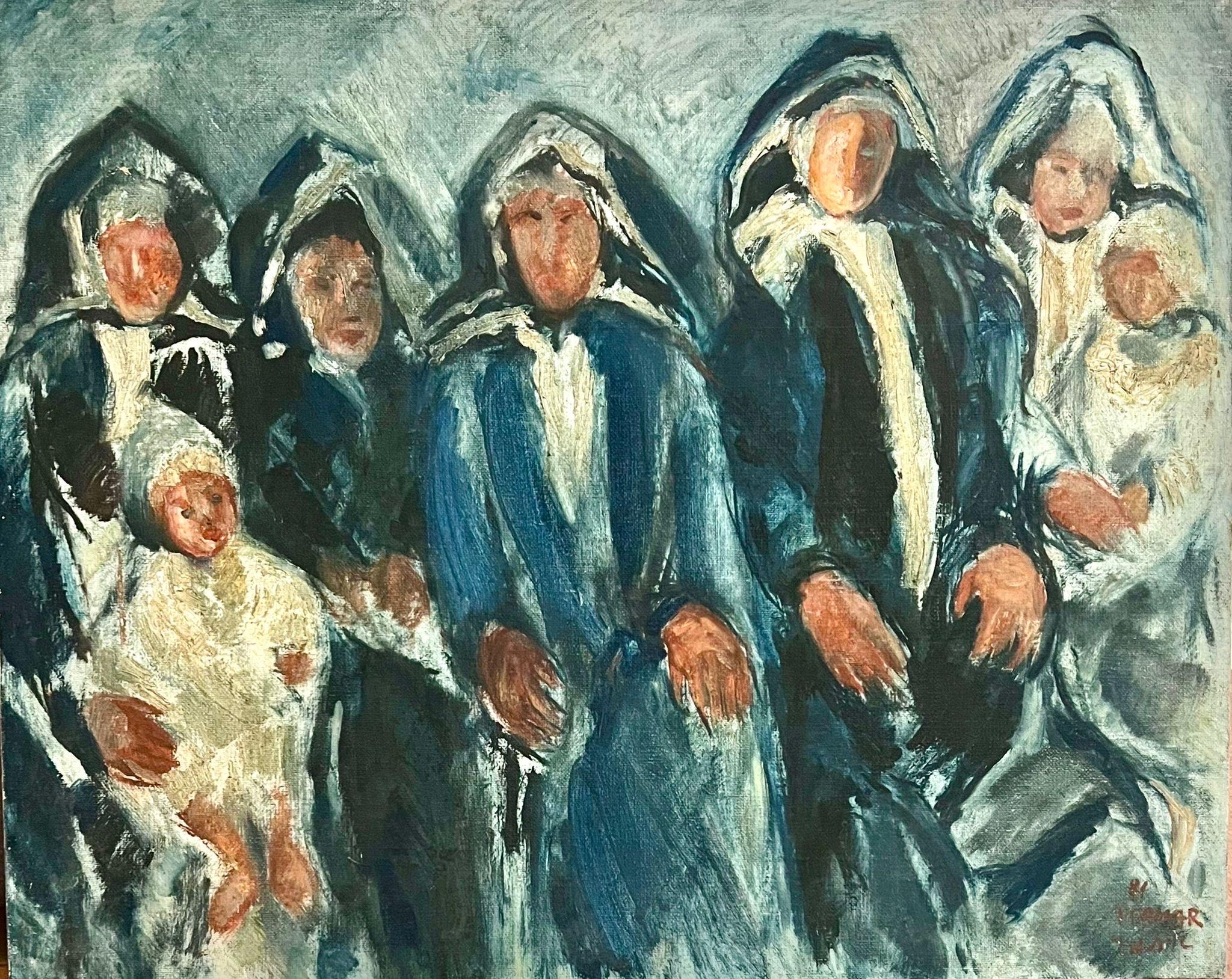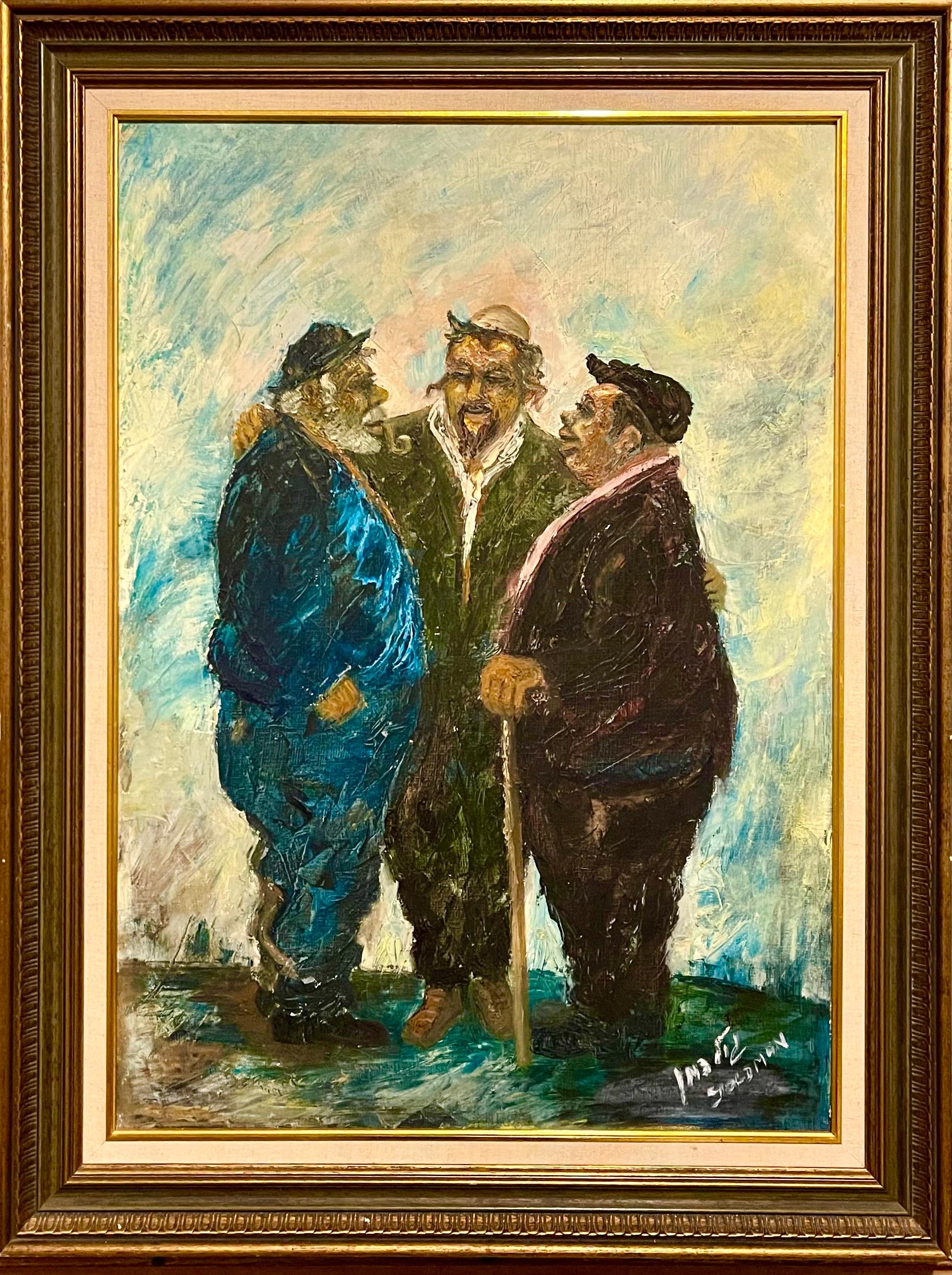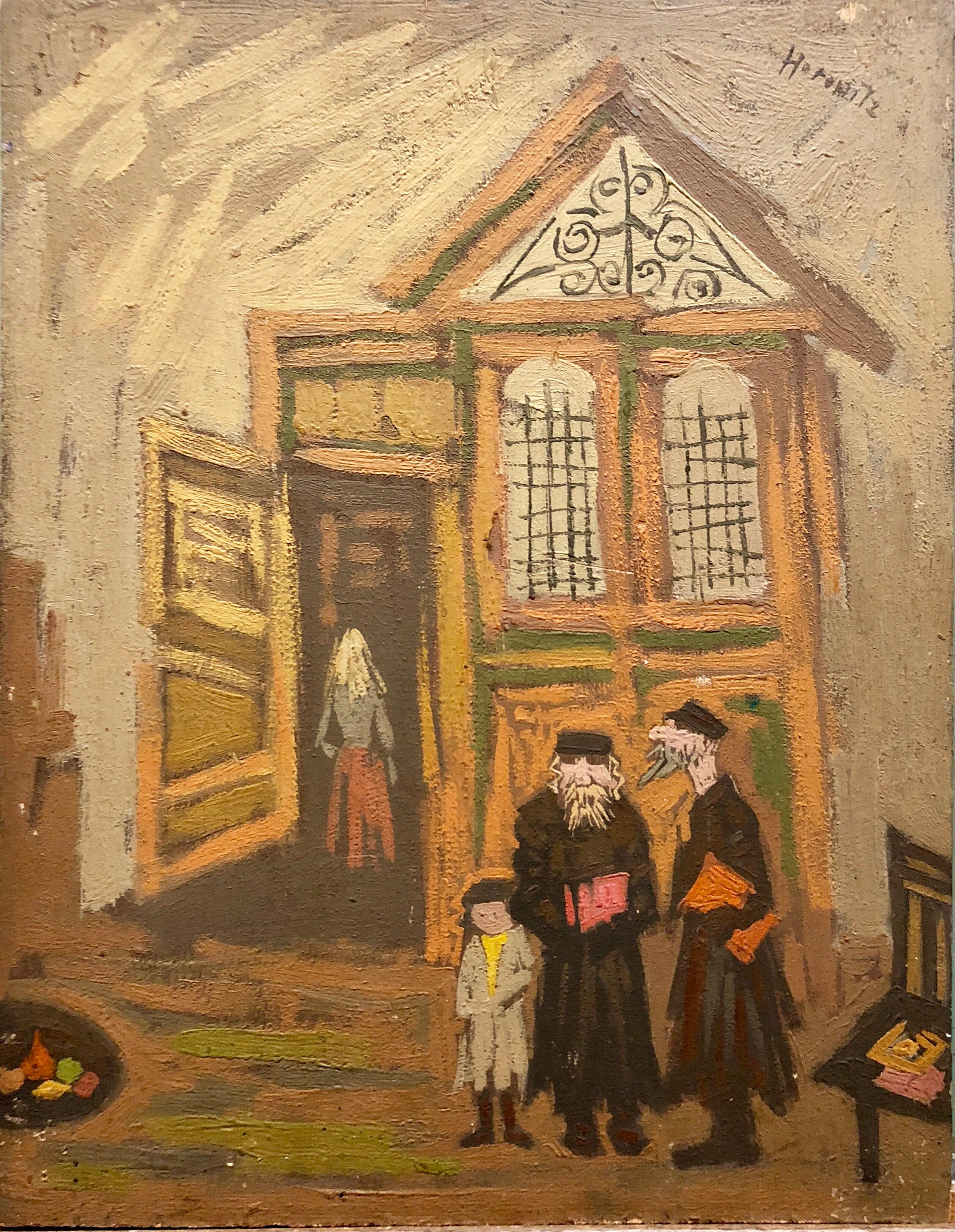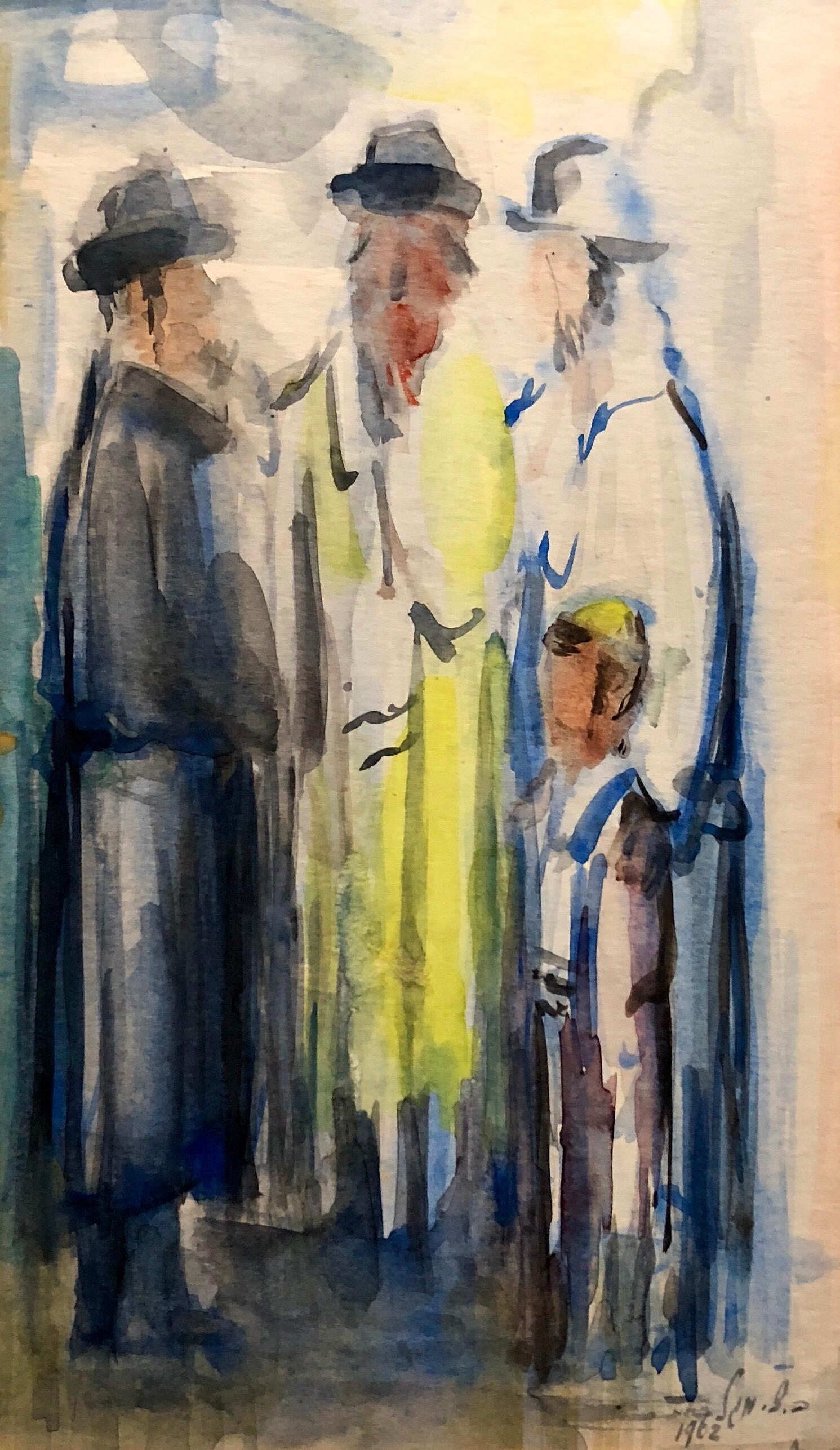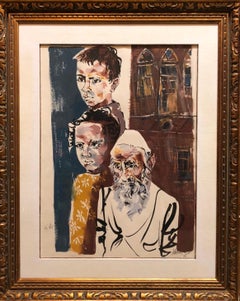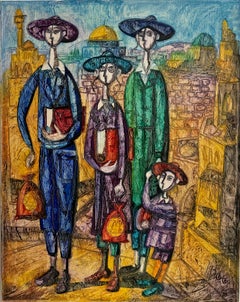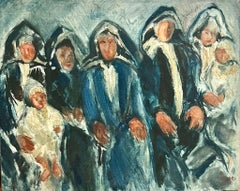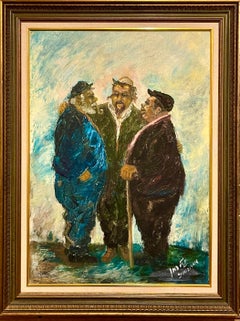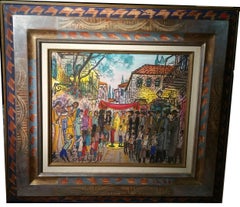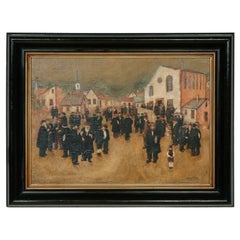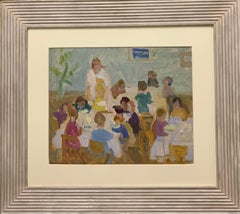Items Similar to Large Judaica Oil Painting Samuel Grodensky Hasidic Rabbi, Children in Jerusalem
Want more images or videos?
Request additional images or videos from the seller
1 of 14
Samuel GrodenskyLarge Judaica Oil Painting Samuel Grodensky Hasidic Rabbi, Children in Jerusalem1962
1962
$1,800
£1,354.33
€1,564.28
CA$2,543.87
A$2,760.49
CHF 1,462.81
MX$33,856.02
NOK 18,102.23
SEK 17,105.64
DKK 11,678.15
About the Item
Samuel Grodensky (1894-1974)
"Hassidim"
Hand signed and dated "Grodensky '62" u.l.,
Titled verso in pencil on stretcher
31" x 27" canvas , 35 1/2" x 31 1/2" framed.
Large Fauvist Expressionist Jewish Family Oil Painting
This is done in an Expressionist style in Fauvist colors. Influenced by the Judaic artists of the early Israeli Bezalel School In Jerusalem, It is a sensitive portrait depiction of a Chassidic family, Rabbi with children, going to synagogue in their Shabbat finery. Of the same period as Tully Filmus, Itshak Holtz, William Gropper and Reuven Rubin. This is a great piece of mid century Judaica at a great value.
- Creator:Samuel Grodensky (1894 - 1974, American)
- Creation Year:1962
- Dimensions:Height: 35.5 in (90.17 cm)Width: 31.5 in (80.01 cm)
- Medium:
- Movement & Style:
- Period:
- Condition:minor wear, frame has wear. please see photos.
- Gallery Location:Surfside, FL
- Reference Number:1stDibs: LU38212230262
About the Seller
4.9
Platinum Seller
Premium sellers with a 4.7+ rating and 24-hour response times
Established in 1995
1stDibs seller since 2014
1,807 sales on 1stDibs
Typical response time: 1 hour
- ShippingRetrieving quote...Shipping from: Surfside, FL
- Return Policy
Authenticity Guarantee
In the unlikely event there’s an issue with an item’s authenticity, contact us within 1 year for a full refund. DetailsMoney-Back Guarantee
If your item is not as described, is damaged in transit, or does not arrive, contact us within 7 days for a full refund. Details24-Hour Cancellation
You have a 24-hour grace period in which to reconsider your purchase, with no questions asked.Vetted Professional Sellers
Our world-class sellers must adhere to strict standards for service and quality, maintaining the integrity of our listings.Price-Match Guarantee
If you find that a seller listed the same item for a lower price elsewhere, we’ll match it.Trusted Global Delivery
Our best-in-class carrier network provides specialized shipping options worldwide, including custom delivery.More From This Seller
View AllLarge Watercolor Painting Israeli Modernist Judaica Rabbi with Children, Bezalel
By Moshe Gat
Located in Surfside, FL
A large watercolor painting.
Moshe Gat was born in Haifa in 1935.
in 1952 he began his studies at the Bezalel School, in Jerusalem.
In 1955 he returned to Haifa, where he taught dra...
Category
Mid-20th Century Expressionist Figurative Drawings and Watercolors
Materials
Paper, Watercolor
Jerusalem Hasidic Family Oil Painting Israeli Judaica Yossi Stern Bezalel School
By Jossi Stern
Located in Surfside, FL
Jossi Stern Hungarian Israeli 1923- 1992)
Untitled (Figures, Chassidic Family, Father and Sons),
Oil on canvas,
Hand signed lower right,
Provenance: gallery label (Safrai Art Gall...
Category
20th Century Modern Figurative Paintings
Materials
Canvas, Oil
Rare Jewish Yemenite Family Oil Painting Israeli Judaica Itamar Siani
By Itamar Siani
Located in Surfside, FL
Itamar Siani, Israeli artist, painter, engraver, born 1941, Yemen
His art commemorates the unique cultural heritage and traditions of the Yemenite Jewish community, who returned to the Promised Land on "Eagles' Wings," the code name of the Israeli rescue of Yemenite Jewry in 1949. Among his notable works is a ten-meter long oil painting depicting the immigration of the Yemenite Jews, which he worked on for 30 years.He did a celebrated series titled "The Magic Carpet" etchings depicting stages in the artist’s life including: Liberation, The Magic Carpet, Refugees, New life in Israel, Family, Mount Sinai. published in Jerusalem 1973. The artist was born in Sana’a in Yemen and flown to Israel aged 5 years old as part of operation ‘Magic Carpet’ the mass migration that transported almost the entire Jewish population of this part of the Arabian peninsula to the new State. The etchings continue and develop a long tradition of Yemenite artistry. Yemenite born Israeli painters Avshalom Okashi...
Category
1970s Neo-Expressionist Figurative Paintings
Materials
Canvas, Oil
Sephardic Jewish Men Vibrant Judaica Vintage Oil Painting Israeli Artist Goldman
By Albert Goldman
Located in Surfside, FL
This depicts Middle Eastern jewish men of Sefardic descent. At least one appears to be a Rabbi.
ALBERT GOLDMAN Born in Alexandria, Egypt in 1922, Albert Goldman started drawing and ...
Category
20th Century Modern Figurative Paintings
Materials
Canvas, Oil
Judaica Oil Painting Jewish Family Interior Shtetl Scene
By Peter Horowitz
Located in Surfside, FL
Peter Horowitz, painter, born 1922, Poland. Lived in Hod Hasharon in Israel.
Studied at the Art Academy, Krakow. died in 2005.
Studies: Art Academy, Cracow. Peter Horowitz was born...
Category
Mid-20th Century Modern Figurative Paintings
Materials
Oil, Board
Israeli Judaica Watercolor Gouache Bar Mitzvah Boy Rabbi Painting Russian Artist
By Ben Zion Magal
Located in Surfside, FL
Ben Zion Magal (1908 - 1999)
Ben Zion Magal was born in 1908 in Kishinev - Russia and there, years later, graduated from the Art Academy. He arrived to Erertz Israel together with hi...
Category
1960s Neo-Expressionist Figurative Paintings
Materials
Watercolor, Gouache
You May Also Like
Wedding in Jerusalem
By Zvi Raphaeli
Located in Saratoga Springs, NY
Signed lower left.
Provenance: Private Collection, Boca Raton, Florida
Zwi Raphaeli was an Israeli impressionist painter. He studied in Paris at the Beaux-Arts and the Bezalel Acad...
Category
20th Century Impressionist Figurative Paintings
Materials
Paper, Gouache
20th Century oil painting of the Jewish Chassidic community by the synagogue
By Elek Gyori
Located in London, GB
Elek Gyori (Hungarian, 1905-1957) was an Eastern European painter, who was notable for his fine paintings of the everyday life in rural Hungary. This beautiful oil painting, portrayi...
Category
Mid-20th Century Impressionist Figurative Paintings
Materials
Canvas, Oil
Parading the Torah, Impressionist Oil Painting on Canvas by Adolf Adler
By Adolf Adler
Located in Long Island City, NY
Artist: Adolf Adler, Romanian (1917 - 1996)
Title: Parading the Torah
Year: circa 1965
Medium: Oil on Canvas, signed l.r.
Size: 19.5 x 27.5 in. (49.53 x 69.85 cm)
Frame Size: 21 x 29...
Category
1960s Impressionist Figurative Paintings
Materials
Oil, Canvas
$3,600 Sale Price
20% Off
"Kindergarten, children" Oil cm. 36 x 48 , 1960 , shipping free
By Nadezhda VOROBIEVA
Located in Torino, IT
Child,children,russian,art,1960
NADEZHDA VOROBIEVA (Moscow, 1924 - 2011)
Works by Nadezhda Vorobieva can be found in various private collections in Europe, Japan, United States an...
Category
1960s Realist Still-life Paintings
Materials
Oil
Hebrew School, Judaica Oil Painting by Bernd Werner
By Bernd Werner
Located in Long Island City, NY
Artist: Bernd Werner
Title: Hebrew School
Year: circa 1930
Medium: Oil on Canvas, signed
Size: 10.5 x 12.5 in. (26.67 x 31.75 cm)
Frame Size: 14 x 16 inches
Category
1930s Impressionist Figurative Paintings
Materials
Canvas, Oil
20th Century German Modernist Oil Painting Figures Colorful Street Scene
Located in Cirencester, Gloucestershire
Artist: Elisabeth Hahn (German 1924-2021),
Elisabeth Hahn was born in Dortmund, Germany, where she began her artistic studies. In 1953, she moved to Paris. She continued her studie...
Category
20th Century Figurative Paintings
Materials
Acrylic
More Ways To Browse
Jerusalem Paintings
Jewish Oil Painting
Painting Oil Jerusalem
Portrait Of Rabbi
Pattern Portrait
Piano Paintings
Pool Contemporary Painting
Portrait Of Clown
Snake Painting
Vietnamese Artist
Cuban Oil Painting
Kiss Oil Painting
Leyendecker Oil Painting
Peter Max Acrylic
The Birth Of Venus Painting
Alexander Litvinov
Fabric Artwork
Grand Masters
